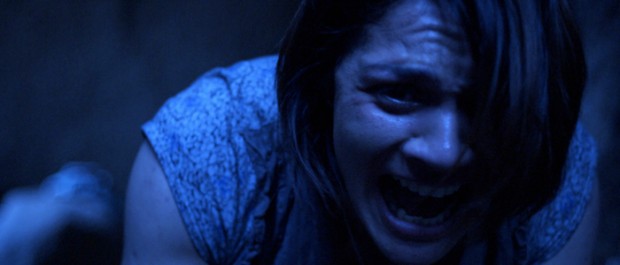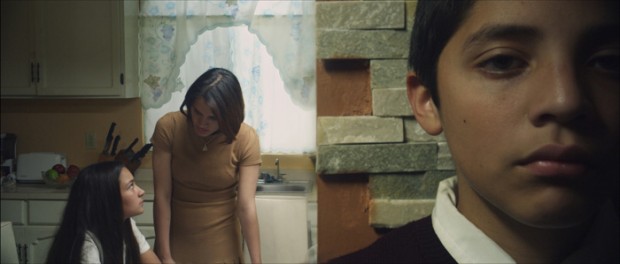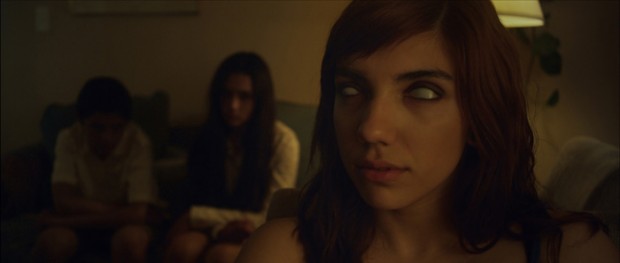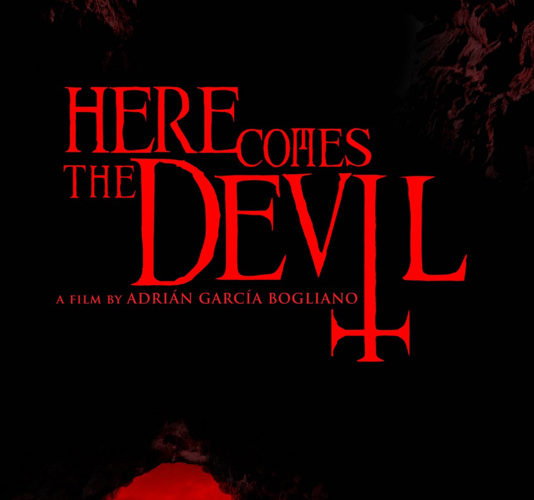If ever a horror film begged for multiple viewings, Here Comes the Devil (Ahí va el diablo) makes a good case. In fact, until a little over halfway through I was completely checked out. I saw what writer/director Adrián García Bogliano was doing, but the on-the-nose sexual juxtapositions of womanhood, devil rape, and a lust for violence lost me. Highly carnal, full of allusions to demonic possession, and presented so matter-of-fact that it becomes discomforting, a streak of cruelty without justified reason introduces how evil exists in us all. However, when Sol (Laura Caro) decides to follow her children as they skip school, what she discovers changes the dynamic of the film by adding a concrete chain of events revealing the eccentric Tijuana cast of characters’ true motivations. The Devil isn’t coming; he’s already here.

García Bogliano wants to play with preconceptions. He doesn’t want to give us the same old horror film with possessed children creepily crawling on the ceiling like Hollywood has loved doing of late. Right from the opening scene I was scratching my head, completely in the dark for what may be coming. Reading the synopsis state it would be about two parents whose kids disappear into a cave and return changed does not prepare you for a credit sequence set to two naked women (Dana Dorel and Jessica Iris) engaged in intercourse that segues into a serial killer (Juan Carlos Arreguin) breaking up the party. That’s jarring enough to have you wonder if you stepped into the correct theater. But don’t worry—it’ll make better sense by the end.
It’s the main plot line then that originally disrupts this sense of surprise. Here is where young Sara (Michele Garcia) becomes a woman and cheesy camerawork cuts between her mother and the disquietingly strange Lucio (David Arturo Cabezud) frozen outside a gas station bathroom staring at the resulting bloody panties on the sink. It’s a laughable sequence that goes overboard in its desire to plant a seed of villainy for the future. Pair it with the blatant crosscutting of Sol and husband Felix (Francisco Barreiro) pleasuring each other in their hot car while Sara and her brother Adolfo (Alan Martinez) enter a cave’s hillside black gash unsubtly mirroring the feminine sex organ stimulated below and you can’t be faulted for exasperation at the heavy-handed clumsiness.

But then something changes. I don’t know if the cheese necessarily disappears, but the intrigue of what’s happening definitely crescendos. From the stoic kids covered in bruises to their drawings of a pick-up truck up by the hill to the parents’ bloodlust for retribution, the film takes a dark turn. What really catches you off-guard, however, is how no one really seems too affected by what’s going on. Sgt. Flores (Giancarlo Ruiz) hints at understanding how murder could be justified, Sol and Felix become too wrapped up in the health of their kids to show remorse for any of their actions, and Sara and Adolfo begin growing a bond way beyond any siblings I know. There is a palpable air of evil around them and it’s growing as it consumes them all.
There is a lot to like in Here Comes the Devil if you’re willing to look past its shortcomings. What at first looks to be low production value will soon turn into a deliberate stylistic choice as static-filled sound design and flickering, buzzing lights revealing the devil’s presence prove García Bogliano has the means to amp up the suspense. Characters like Enrique Saint-Martin’s gas station attendant may be too easily knowledgeable of the proceedings and expository about the plot, but others like Barbara Perrin Rivemar’s babysitter Marcia will stun by their direct contact with the darkness. In a gorgeously conceived strobe of imagery, listening to Marcia’s account of her nightmarish stay with Sara and Adolfo is by far the piece’s highlight.

Viewers simply need to accept that García Bogliano isn’t going to necessarily hold your hands and guide you through—even when perhaps he should. Actors shift back and forth from over-the-top to authentic and the eventual revelation of what occurred in the cave has the potential to infuriate by revealing the layers of artifice distracting our attention, but the nuance in the devil’s depiction itself makes up for such maneuvers. Like Azazel in Fallen or Bob in “Twin Peaks”, such evil doesn’t need to take cartoonish form for us to understand its power. We all have the capacity to give in to the dark side of our nature and let him enter our souls. The rampant earthquakes may be a physical representation of the devil leaving his Hellmouth hole, but it’s the characters’ absence of conscience that proves he’s set up shop and is here to stay.


